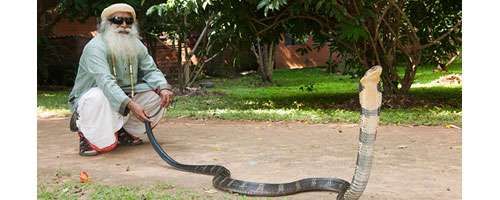Life on Fast-Forward
In this week's Spot, watch the video of Sadhguru handling the magnificent king cobra as he shows the residents of the Isha Yoga Center its rare nature. Sadhguru writes, "It is an incredible creature of phenomenal beauty and power. Energetically, it is so addictive and intoxicating to be in intimacy with this wonderful creature." Sadhguru also writes about Saturday's lunar eclipse, and how seekers can make use of this last week before the winter solstice. Enjoy!

The sathsang during the eclipse was very special; the lunar eclipse always occurs on a full moon night. The full moon means many things to many people. The word moon or soma means ‘intoxication’. For some it suggests pleasure, for some it means romance, for some it means celebration. For a seeker it means a night of great possibility; it is a blossoming. For a devotee, it is a day to merge and mingle with all of creation.
Saturday’s lunar eclipse was a different kind of full moon. What an eclipse means for a spiritual seeker is this - we pass a whole month in about three hours time. All the different faces of the moon, the twenty-eight faces of the moon, you will see within these three hours; starting from the first day’s moon, to the no moon, to the full moon. So your life is put on fast-forward and essentially, spirituality means just this. It does not mean we are taking a different path; it is just that we are putting our lives on fast-forward. If you are walking on foot, you can see if there are mangoes in the trees and you can pluck them and eat. You can taste the nallikai* on the way. You can picnic, you can pee; this is the journey. But if you are on an airplane, you are not going to pluck mangoes on the way. You don’t even look at them. There may be ten thousand acres of mango groves down there but you don’t even look at them because you are going at a certain speed and elevation. So we are on fast-forward, not that we have anything against mangoes, but we can’t be plucking because of the speed and altitude.
During a lunar eclipse, the moon is on fast-forward. You will see all twenty-eight faces. Everything that happens in a month is happening in a subtle way within a few hours time. When such a fast-forward is happening, many things are changing. This is happening because in terms of energy, the earth’s energy is mistaking the eclipse as a full cycle of the moon.
Subscribe
This is also the last phase of Dakshinayana, or the sadhana pada in the yogic system. During Dakshinayana, the sun is towards the Southern Hemisphere. During Uttarayana, it is more towards the Northern Hemisphere. In the yogic tradition, Dakshinayana is seen as the period of sadhana. Uttarayana** is seen as the period of enlightenment, and it is not by accident that so many yogis attain to their ultimate state at the beginning of this phase. The most famous one in this country is Bhishma himself, who waited on the bed of arrows so that he could shed his body in Uttarayana, when the tilt happens on the planet.
So for those of you who have taken your sadhana seriously, the next week is very significant. Is the planet deciding everything about us? No. But it is good to make use of the support that the planet offers. You can create a greenhouse and grow any kind of crop in any season, but in certain seasons crops happen naturally. A wise farmer would choose the right season. Do you want to plough and plant in the summer season? Not that it cannot be done, it can be done; it just takes much more effort. This is a time when things happen so much more easily because somebody as big as mother earth is working for you. It is a good support; it is wise to make use of the support. This final week preceding the winter solstice is a time to peak your sadhana in many ways.
The Adiyogi Alayam is rapidly taking shape. A large portion has been roofed and the rest is progressing at an insane pace.
It has been a long time since I actually touched a king cobra. The king cobra is a very special creature. It is the only creature of its genus. Though it is referred to as a cobra because of its king-sized hood, it does not belong to the Naga as all the other cobras do, but belongs to the Ophiophagus Hannah genus. It is an incredible creature of phenomenal beauty and power. Energetically, it is so addictive and intoxicating to be in intimacy with this wonderful creature. There was a time in my life when snakes were my constant companions. It is truly an honor to be in the company of a king cobra, something very few in the world would understand and appreciate.
The Naga tribes of India and Southeast Asia were held in great esteem in Eastern cultures. Their intuitiveness, perception of trikala - or three dimensions of time - and their legendary beauty were valued and honored. As the human creature became too conceited and more venomous than the cobra, they seem to have lost their significance.
* Amla or gooseberry
** Uttarayana begins on December 22, 2011


